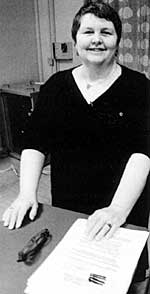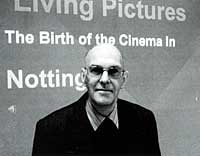Events and excursions, Winter 2009
The Nottinghamshire History Lecture,
14 November 2009
Stevenson Revisited: A Fresh Look At Nottingham's Borough Records, 1400-1600. Judith Mills

Judith Mills is a mature student at the University of Nottingham, and she is shortly to submit her Ph.D thesis on 'Continuity and Change: the town, people and administration of Nottingham, c1400-c1600'.
Thorotonians were given a taster of her findings in the context of a discussion which focussed on the work of the Victorian scholar, W. H. Stevenson, who edited the first four published volumes of the Records of the Borough of Nottingham. Judith has delved deeply into Stevenson's work, and her lecture teased out some of his priorities in selecting and editing records. In particular she noted his emphasis on legal matters.
In her work, Judith has compiled a database of 6,700 Nottingham people during the fifteenth and sixteenth centuries. She knows very little about some of them beyond their names, but for a few she can almost write a biography. We learnt about the litigious Bartholomew Chettle - no relation to any members of our Society! And we learnt about the conflicts between the corporation and the Mickleton Jury, all of which were tied up with issues of town governance. In the wake of Trevor Fould's earlier work on the Borough Court Rolls, Judith showed us just how rich the written record is for medieval Nottingham, and the lively question time at the end of the lecture revealed just how interesting members found her work. An extended text will appear in the next Transactions, and we wished her well with submitting her thesis.
John Beckett
The Christmas Lecture, 12 December 2009
Animated Photographs And Living Pictures: The Beginnings Of Cinema In Nottinghamshire. Bob Massey

Rob Massey is a professional member of the Association of Lighting Designers and of the Association of British Theatre Technicians. He is Technical Manager of the Bonington Theatre in Arnold, has his own theatre consultancy business and is a founder member of the Arnold Local History Group. He has a great interest in the history of Arnold as well as matters theatrical and is an avid collector of early films. Bob was, therefore, very well qualified to introduce the room full of members and guests to the joys of moving film at the end of the 19th and beginning of the 20th centuries.
Bob explained that the earliest moving picture shows were given in mobile units owned and operated by the showmen who travelled the country's fairgrounds with large shows and exhibitions. Moving film, known at that time as animated photographs, was initially a small part of the entertainment provided by such showmen as William Randall, Pat Collins, George Green, President Keen, William Haggar, George Biddell, Jack Proctor and the Chipperfields, most of whom were millionaires from their show activities.
The films were shown in mobile units called Bioscopes, pulled by horses until the appearance of the traction engine whose power allowed for larger and longer units. The units were very elaborate on the frontage and grew even more elaborate as their size increased and the popularity of film shows grew. The Bioscopes had a platform at the front where an employee sought to encourage people to enter and enjoy the entertainment. Eventually, up to 1,000 people at a time could be seated. They paid two old pence to see a 10 minute film show; the shows were given from 9 am to midnight, so it is easy to understand the amount of money being made by the showmen. The Bioscopes had organs built into them and the films were accompanied by music and a Chairman who explained to the audience what was going on, much as in Old Tyme Music Hall.
Goose Fair, Nottingham, was the largest such fair in the UK at the time and was the first place in the country to show animated film (movies). The first occasion was in 1897 when Randall Williams, who was known as the 'King of Showmen, showed a movie. Williams had bought the necessary equipment after seeing it displayed at the Royal Agricultural Hall fairground show in 1896 and had recognised that it would be an addition to the entertainment which he was then presenting at fairgrounds. His lead was soon followed by others. Movies were a great novelty to the public and even seeing a film of the sea was popular since most people had never visited the seaside. An early film, which Bob showed us, was of about one minute's length and showed Queen Victoria walking. The quality of the film was poor, and the action jerky, but proved highly popular with the people of the day, it being a great novelty to be able to see the Queen. Newspapers of the time were sparsely illustrated so to see a picture of the Queen, let alone her walking, was most novel.
We were shown other very early films, Anabelle's Serpentine Dance was short, as they all were, but shown in colour with every frame having been carefully hand-tinted. We also saw a film about Christ's Ascension which was apparently shown in 16 parts, each of short duration, so that people had to pay 16 times to see it all; that cost being substantial when one considers the level of weekly earnings of the ordinary worker at the time.
An amusing clip shown to us was the chase and apprehension of two poachers and this was followed by a clip from Uncle Tom's Cabin. Films of the general public were made at the venues visited by the showmen and the public was keen to pay to see film of themselves.
Fires were not uncommon due to the film stock being highly flammable and people being allowed to smoke in the Bioscopes. In 1901 regulations were introduced to bring some safety procedures into being. As films became longer and more popular, purpose built permanent cinemas were erected. The first one in Arnold opened in 1911. This movement to permanently sited cinemas lead to the demise of the showground Bioscope which had ceased to operate by 1913.
There was much more that Bob could have explained to us given more time so, perhaps, we shall invite him back at a future date. It was fascinating to see such early movies, to learn about how they were shown by the showmen of the time and to learn that Goose Fair in Nottingham's Market Place was where they were first seen by the public in this country. Bob's talk was an excellent one for our Christmas Lecture and greatly enjoyed by the 80 or so members present.
Howard Fisher
The Nora Witham Lecture, 9 January 2010
Conservation and Decoration In The National Trust. Andrew Barber
Our Lecture in January should have had a special emphasis on recent work at Hardwick Hall and Belton House. However, the snowy weather somewhat altered what had been planned because Clumber Park was inaccessible, which was where our speaker's office containing the presentation is situated. The audience, large for such a wintry day, was not disappointed in the replacement lecture, for Andrew Barber, Curator for the National Trust in the East Midlands, gave an excellent illustrated talk on Hardwick Hall and its first fifty years in the care of the National Trust.
Andrew has worked for the NT since 1984, twenty of those years in the East Midlands, and during that time has been involved in the care and presentation of the great estates and their collections, gardens and parks. He is especially interested in how estates worked in their heydays, in the way they were decorated and the tricky area of how best to undertake repairs to buildings and items.
Andrew explained how Hardwick was handed over to the Treasury by the Duke of Devonshire in 1956, which duly passed it on to the National Trust in 1959 although the contents continued to be administered by the V&A until the 1980s. The builder of Hardwick, Elizabeth Countess of Shrewsbury, achieved unprecedented success in her times, being the most powerful and richest woman in England except for Queen Elizabeth herself. As such she was a target for the criticism of men of the time, but how many of them could boast of establishing three ducal lines as well as being an incredible builder of beautiful houses?
After Bess's death, Hardwick Hall became a secondary house for the Dukes of Devonshire and, as such, Andrew told us that it did not suffer a great deal of change like most other great houses. As well as being much as Bess left it, the house also contains the best collection of 16th century state furniture in the country, much of it noted in Bess's inventory of 1601. He also explained the difficulties in keeping the house in good repair, not new to our times but constant throughout its history. Problems included the presence of six collieries within five miles, so pollution has been an issue and Andrew pointed out that the corner towers apparently had a constant desire to head outwards.
We also heard how pictures had been hung over those precious Gideon tapestries in the Long Gallery since at least the mid 18th century, that the Hall is abundant in at least five or six mason's marks and that replacement antlers on the roof line had to be sourced from young stags because modern deer are bigger than those of Tudor times. Andrew also drew our attention to the quality of the original window glass and called the replacement of original glass in old buildings a tragedy as its quality and the play of light across facades such as Hardwick's is lost forever. It was a fascinating talk and Andrew promised that he would come back again at a future date to give his scheduled talk.
Barbara Cast
VISIT TO WARWICKSHIRE - 10 SEPTEMBER 2009
On September 10, 2009, we enjoyed a visit to the village of Mancetter and to Arbury Hall, the home of Viscount Daventry. Our first stop was at St .Peter's church in Mancetter where we were given a warm welcome and enjoyed an excellent cup of coffee and biscuits.
One of the Church Wardens gave us a fascinating talk, not only about the history of the church, its chained books and its unique protestant Martyr's memorials, but also on the present life of the Church and its parishioners.
From Mancetter we drove a short distance to Dobbie's Garden Centre for lunch, and then in the afternoon on to Arbury Hall. The Hall is the family home of Lord and Lady Daventry and is only open to the general public on Bank Holiday weekends.
We were welcomed by Mrs. Brenda Newell, the agent of the estate. Her 19th century predecessor in this role was the father of the novelist, George Eliot who portrayed Arbury in several of her novels, especially, Scenes of Clerical Life. We were divided into two groups and given a tour of the house, a Tudor building whose rooms were beautifully gothicised in the 18th century. The rooms are filled with family portraits from the 16th century to the present day to give, despite the elegant architecture, a true feel of a family home.
During a splendid 'Thoroton' tea in the estate tea room we were given an interesting talk by Adrian Henstock on the Newdigate family and their connection with Nottingham and of the Evans (George Eliot's family) and their connection with his own. I should like to thank him for giving his time and this talk was thoroughly enjoyed by us all.
We had the additional bonus of the day being a lovely, warm, late summer's day with bright sunshine throughout.
Penny Messenger